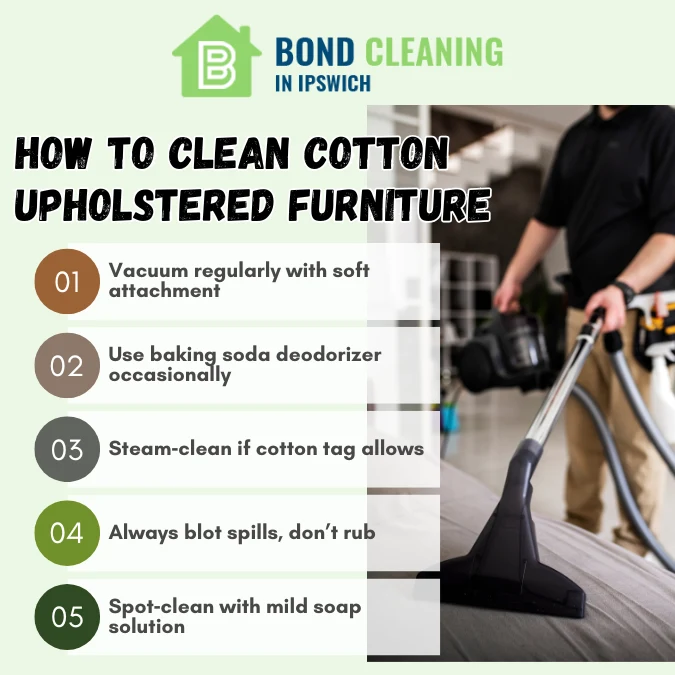
The Ultimate Guide To Cleaning Cotton Upholstered Furniture
Cotton upholstery is a popular choice among homeowners due to its comfort, breathability and timeless appeal. However, these natural fibres may trap dirt, dust, and stains, so you’ll need to clean them on a regular basis to keep your furniture looking fresh and lasting. If you don’t give it the care it needs, even the most beautiful cotton sofa can start to look worn and tired over time.
Whether you’re dealing with ordinary dust or accidental spills, using the proper cleaning strategies for cotton upholstery can make all the difference. This blog explains everything you need to know about cleaning cotton upholstered furniture. And if you’re getting ready to leave a rental, these tips will come in handy, especially if you’re thinking about budget bond cleaning Ipswich to meet the end of lease cleaning requirements.
1. Know Your Fabric: Understand Before You Clean
Before commencing any cleaning tasks, it’s important to identify the type of cotton fabric you are working with. Cotton upholstery is available in a range of finishes and combinations; some is pure cotton, while others incorporate synthetic fibres for enhanced durability. For manufacturer instructions, always see the care label. While some cotton covers may be removed and machine washed, some need to be spot cleaned or cleaned by a specialist.
If there is no label or if you are unsure, do a spot test with a small amount of cleaning solution in an inconspicuous area. This helps to prevent discolouration or damage. Understanding your fabric type not only aids in selecting the appropriate cleaning procedures, but also extends the life of your upholstery.
2. Regular Maintenance: Vacuuming and Dusting

Cotton upholstery is prone to dust and crumbs and requires regular maintenance. To keep dirt from being absorbed deep into the fabric, vacuum your furniture once a week with a soft brush attachment. And for the seams & fissures, give them additional attention as they are prone to collecting debris.
In addition to vacuuming, a little dusting with a lint roller or microfiber cloth will help remove pet hair and grime from the surface. Routine maintenance is essential for renters preparing for bond cleaning in Ipswich since it not only keeps their furniture in good shape but also removes deposits that can cause fabric damage or long term discolouration.
3. Spot Cleaning Stains the Right Way
Accidents happen, be it a splash of coffee, food stains or muddy paw prints. Spot cleaning is your best bet to treat spills before they set. Blot the stain immediately with a clean, dry cloth; never rub, as that can push the stain deeper into the fibres.
Use a mild solution of water and gentle dish soap or a fabric specific cleaner. Apply with a clean sponge, gently dabbing at the stain. Once treated, dab with a damp cloth to remove any soap residue before drying with a towel. To avoid mould and mildew, always ensure that the area is fully dry. Treating stains quickly might help keep your cotton furniture looking good in between deep cleaning.
4. Deep Cleaning: When and How
While regular upkeep goes a long way, your cotton upholstered furniture needs a deep clean every 6-12 months, depending on usage. Start by vacuuming the area thoroughly to remove any loose dirt. Then, if your fabric type allows, use a fabric safe steam cleaning solution or upholstery wash.
If deep cleaning appears too difficult or you’re scared about damaging the delicate fabric, don’t hesitate to call in the professionals for some help. Renters can schedule a professional deep cleaning before moving out to ensure their furniture looks its best, especially if it’s part of a Bond Cleaning Ipswich checklist. It’s a sensible decision to avoid losing your bond over a discoloured or dirty sofa.
5. Odour Control: Keep It Smelling Fresh
Cotton fabric is known to absorb not only dust and stains, but also odours from food, pets, and daily use. To keep your home feeling fresh, deodorise your cotton upholstery on a regular basis. Baking soda is a simple and effective treatment; simply sprinkle a suitable amount on the surface, let it soak for 15-30 minutes, then vacuum thoroughly. This helps to eradicate persistent odours without the use of harsh chemicals.
You can also use fabric safe upholstery sprays that are intended to remove odours. Choose ones with delicate, natural scents that will not overpower the room. If you prefer to manufacture your own solution, a spray bottle with water and a few drops of essential oil will do. Keeping your furniture smelling fresh is especially important while preparing for end of lease inspections, where every detail matters.
6. Preventive Measures: Protect and Preserve
Prevention is better than cure, especially when it comes to cotton furniture. Slipcovers, throws, and armrest covers can help to prevent daily wear and tear. Select washable slipcovers that can be tossed in the washer for a quick refresh.
Also, keep your furniture away from direct sunshine, which may cause the cotton fabric to fade with time. To ensure even wear on cushions and seat pads, rotate them on a regular basis. Small changes like these can help maintain the appearance of your cotton upholstery while also making cleaning easier.
How to Clean Cotton Upholstered Furniture

Wrapping Up
Cotton upholstery is a timeless choice, but it requires regular maintenance to keep it looking and feeling its best. From weekly dusting and vacuuming to deep cleaning and stain removal, every little effort helps keep your furniture looking fresh and new. A clean home shows how much you respect your area, and not just its appearance.

